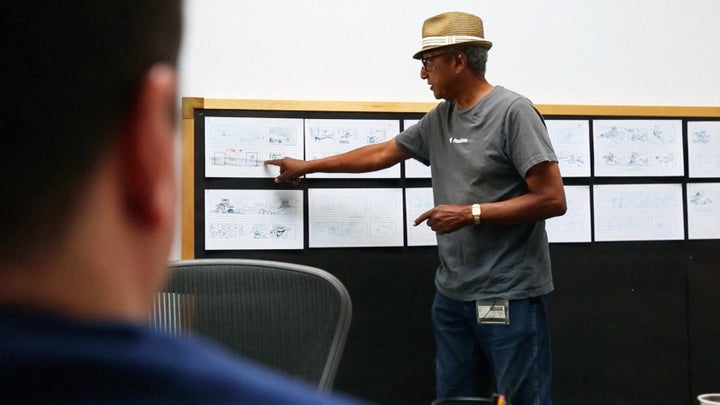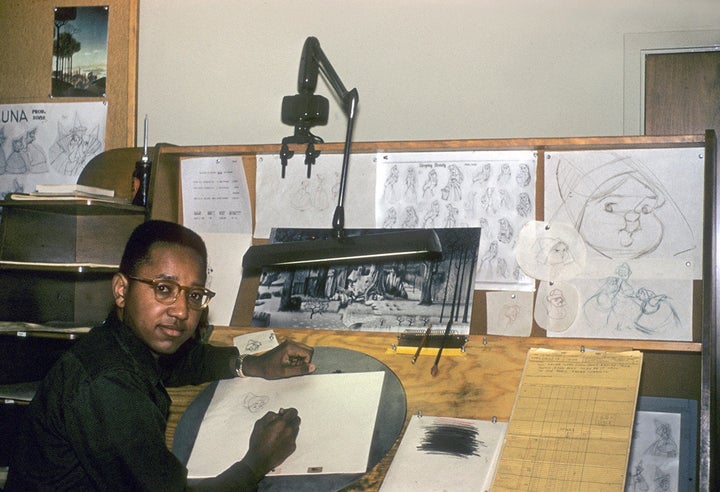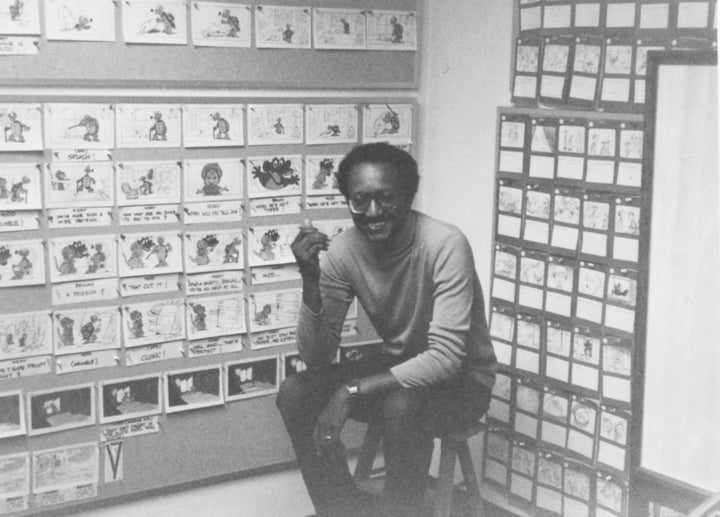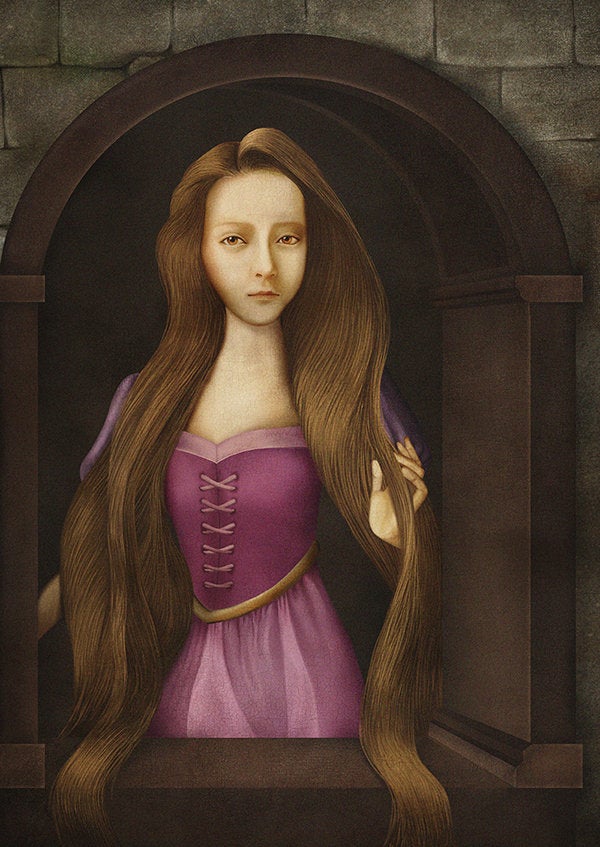Everything Floyd Norman says is worth writing down. The longtime Disney animator carries an impossibly sunny disposition, almost always speaking in complete sentences with enviable poise.
That’s not empty flattery. Norman’s colleagues seem to agree. For proof, see the new documentary “Floyd Norman: An Animated Life.”
Opening in limited release and premiering on VOD platforms this weekend, the movie traces its 81-year-old subject’s boundless devotion to Disney. In 1956, Norman became the studio’s first black animator, working alongside Walt Disney himself as a story artist on such classics as “Sleeping Beauty,” “Mary Poppins,” “The Jungle Book” and “Robin Hood.”
Norman left Disney after Walt’s death in 1966, instead capturing footage of the civil-rights movement and working on other animated properties, including “The Smurfs,” “Alvin and the Chipmunks” and “Fat Albert.” His devotion brought him back to Disney in the ‘90s, when he contributed to “The Hunchback of Notre Dame,” “Mulan,” “Monsters, Inc.” and more. But Norman was forced into retirement at age 65. He was understandably bitter, but Disney was home. Norman began showing up with his wife, who works at Disney Publishing, and his celebrity status around the campus grew. That led, inevitably, to more gigs, meaning he is, once again, employed at Disney.
The documentary, directed by Michael Fiore and Erik Sharkey, is a sweet take on a life devoted to merriment. That Norman broke boundaries along the way is, in his eyes, happenstance. I hopped on the phone with Norman earlier this week to gab about Disney’s history.
You arrived at the tail end of Disney’s golden days, and you left right as the quality waned in the ‘70s and ‘80s. Then you returned after the proverbial Disney Renaissance hit in the ‘90s. So you’ve pretty much only been there when the studio was thriving.
I never felt like I really left, though. Even though I wasn’t part of that ‘80s and early ‘90s renaissance, I was still nearby because I was working at Disney Publishing. So I was still able to watch it all firsthand.

It’s easy for us to make assessments from the outside looking in, but was everyone aware internally of the changing perceptions of Disney’s quality?
Oh, sure, sure. I came to Disney in the last of the golden era with Walt Disney and a lot of the people who had been with him nearly from the start, some dating back to the 1930s. I got in on the last 10 years of that golden era, an amazing decade, and I stuck around to see a new resurgence of animation with a new generation of animation artists who began coming in in the 1970s. Those artists who were just out of school, and many of them quite young, would be the leaders of the animation renaissance in the ‘90s and early 2000s.
How much did the Disney brothers’ deaths affect creativity?
Well, you know, times had changed. One era had come to a close and we had a new generation eager to prove themselves, so it was only fitting that, as the old guys began to retire and to die out, we had a young generation in the 1970s, pretty much the way the Disney company had been back in the 1930s, when all of the people who made “Snow White,” “Pinocchio” and “Dumbo” were pretty much kids themselves. It was time for the old guard to move on and time for the new kids to come in.
The section in this documentary about the making of “The Jungle Book” stands out. Someone could make an entire movie about “The Jungle Book.” Its lore is fascinating. The original version was supposed to be much darker.
Oh yes, it was quite a bit different. Now, keep in mind that our original screenwriter, Bill Peet, was trying to do a faithful adaptation of the Kipling novel. Bill had spent nearly a year crafting that screenplay and the storyboards. Bill was basically Walt Disney’s finest story man. He’d been with the company since the 1930s, so he was Walt’s go-to guy. But in this case, after a number of successful years, Walt did not agree with what Bill had done, and the two of them could not see eye-to-eye on this Kipling adaptation. Walt wanted to throw it all out and start over again. Being the boss, that’s exactly what he did.

Did you work on the darker version and then start over again?
No, not at all. The darker version was all Bill. He liked to work alone. By that time, in the middle of the ‘60s, Bill was pretty much his own guy. He liked to work on his own films ― he liked to write them, he liked to storyboard them, he liked to do the entire job by himself. We had no connection to “The Jungle Book” until Bill walked off the film, which he did early in 1966. He basically said, “I quit,” and he walked out of the Disney studio.
Was there a panic moment about the money spent on that first year of storyboarding?
One of the advantages of animation is story development is not a very expensive process, in the sense that a film doesn’t really become expensive until production begins. The film was not in full production ― it was in story development, and that’s not all that costly in terms of motion-picture production. The fact that we had to start over didn’t really impact the budget all that much. However, it did concern us in the sense that we had limited time. We had to turn a movie around and we had about a year to do it. That’s not a lot of time when you consider an animated film and what it takes to get a film to production. We had our work cut out for us. We had to work very quickly, but one of the good things we had is a boss who was able to make decisions on the spot, and Walt Disney was not slow to making decisions.
About how long would you say a movie, on average, takes?
The average animated feature film takes at least three years. That’s been kind of the rule.

You say in the documentary that “Robin Hood” is not particularly good. What do you remember about it poaching some of the animation from “The Jungle Book”? Would you link that to the creative dip that started to set in in the ‘70s?
You know, it’s really funny ― there’s been a lot of talk about the reused scenes in “Robin Hood.” A lot of us animators found that stuff annoying because we really didn’t like the idea. When you think about it as a cost savings, it didn’t save us that much money to pull scenes from existing films. It was just kind of a quirky thing that our director had. Wolfgang Reitherman, who was our director, loved to reach back into the archives and pull out old footage and find ways to repurpose scenes form the earlier films. We would much rather just animate from scratch, but Wolly had this thing about “Well, we’ve done this dance before, let’s go back and use what we did a few years ago.” We’ve since been criticized for reusing the footage. But it was never our idea, and we never really liked doing it.
Disney is now rebooting its animated properties as live-action films. How does it feel to have your work still influencing these movies today?
They’ve been quite popular. Overall, they’ve had more hits than misses. Disney finds themselves in a remarkable position, having a backlog of material that they can reach back and reuse. Most studios can’t go back into their archives and pull out older properties and redo them as easily as Disney. Because these stories are so engaging, they still work, whether as an animated film or a live-action film. It’s kind of like having money in the bank.
Have you seen the new “Jungle Book”? Are you able to see where your fingerprints have carried over to the live-action version?
Very much so. You’ll find that Jon Favreau’s adaptation follows our film pretty closely. You have the same story beats throughout.
Are you proud, or do you feel nostalgic for an earlier time?
It’s a good feeling. It’s good to know that work we’ve done decades ago still has the power to entertain and to move people today. It’s really a compliment to all of us animated filmmakers to see that ideas we developed over 50 years ago are still viable ideas. I was just delighted with what Jon Favreau did with “The Jungle Book.” It is an excellent retelling of our animated film. It gives it a new life, in a way. I’m looking forward to “Beauty and the Beast,” which will be our next animated film that’s moving into live action. These properties have value. The Disney company has been smart enough to know how to take advantage of these incredible resources. Audiences seem to be satisfied with what we’re putting on the screen, so I think it’s a win for everybody.

Now that you’ve seen animation become computerized, would you want to tackle a live-action/CGI blend like that?
Oh, I think it opens up a world of possibilities. One of the things that’s so great about filmmaking today, and I tell this to my young film students, is that they have incredible tools. CGI technology and the new sound systems and digital cameras are amazing tools that enable filmmakers to do things that we could only have dreamed of a few decades past. To me, I think it’s very exciting. It’s true that I come from a tradition of old-fashioned animation. We made our films by hand. Our process was totally analog. Today, with digital filmmaking, it’s like the sky is the limit. Anything that can be imagined can be put on screen, so I find it very exciting. I think there’s probably no greater time to be a filmmaker than today because anything is possible.
We can talk about art and storytelling all day, but Hollywood, at its core, has always been a business. Now more than ever, though, the corporatization of filmmaking is astronomical. What do you think of the franchise culture that’s taken hold, where superheroes are biggest money-makers?
I think the movie business goes through these cycles. Right now we’ve been going through this crazy superhero phase. We’ve been going through a series of remakes, like the recent remake of “Ben-Hur.” Why? Why would anyone think we needed a remake of “Ben-Hur”? These are business decisions that I don’t always agree with, but it’s just part of our business, I guess, and it’s always going to be this way. I tend to look back at this era of special effects and digital blockbusters. I like an old-fashioned, simple film. I recently saw “Hell or High Water,” the new Jeff Bridges movie, which probably doesn’t have a single special effect. It’s just a good, old-fashioned movie taking place in Texas about two bank robbers and the sheriff who’s pursuing them. This could easily have been a cowboy movie set in the 1800s instead of present-day. It’s a simple story, but it’s an effective story, and it really works. For those of us who love film and storytelling, sometimes there’s nothing better than a good, old-fashioned story with interesting characters. You don’t need explosions every five minutes. You don’t need special effects. You don’t need a climax every half an hour.
In 2009, “The Princess and the Frog” featured Disney’s first African-American princess. What did that mean to you?
You know, it was something that was a long time coming. I didn’t work on the film, but I was certainly around when the film was being produced. A lot of the guys who worked on the film were guys I know. Some of the animators I even helped train when they came into the business as kids. So I felt very close to “The Princess and the Frog,” and it was a delight to see an African-American princess on the screen. It just showed that things are changing for the best. We were very excited about it. I think there’s going to be even more changes in the future. I look forward to this business. I’ve always had a very positive outlook on animation storytelling, and I think this new generation of filmmakers is going to take us in new directions. I’m very excited about it. I probably won’t be participating, but I’ll be watching from the sidelines.
What is your proudest Disney contribution?
Being able to work with the old man himself ― being able to work side by side with Walt Disney. That’s gotta be the biggest thing that’s ever happened in my life.
This interview has been edited and condensed for clarity and length.
“Floyd Norman: An Animated Life” is now streaming on Netflix.


